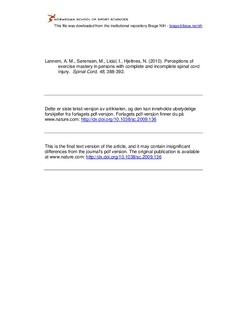| dc.contributor.author | Lannem, Anne Marie | |
| dc.contributor.author | Sørensen, Marit | |
| dc.contributor.author | Lidal, Ingeborg | |
| dc.contributor.author | Hjeltnes, Nils | |
| dc.date.accessioned | 2011-05-02T09:26:26Z | |
| dc.date.available | 2011-05-02T09:26:26Z | |
| dc.date.issued | 2010-05 | |
| dc.identifier | Seksjon for coaching og psykologi / Department of Coaching and Psychology | |
| dc.identifier.citation | Spinal Cord. 2010, 48(5), 388-392 | en_US |
| dc.identifier.issn | 1362-4393 | |
| dc.identifier.uri | http://hdl.handle.net/11250/170755 | |
| dc.description | I Brage finner du siste tekst-versjon av artikkelen, og den kan inneholde ubetydelige forskjeller fra forlagets pdf-versjon. Forlagets pdf-versjon finner du på www.nature.com: http://dx.doi.org/10.1038/sc.2009.136 / In Brage you'll find the final text version of the article, and it may contain insignificant differences from the journal's pdf version. The definitive version is available at www.nature.com: http://dx.doi.org/10.1038/sc.2009.136 | en_US |
| dc.description.abstract | Study design: Cross-sectional study.
Objective: To compare exercise-related self-perceptions in persons with complete and incomplete
spinal cord injury (SCI) and to identify factors that explain the variance of perceived exercise mastery in
the study population.
Setting: Sunnaas Rehabilitation Hospital and the Norwegian School of Sport Sciences, Norway.
Methods: A total of 116 respondents (47 persons with complete and 69 persons with incomplete SCI)
answered a questionnaire measuring self-rated physical exercise habits and self-perceptions in exercise.
Respondents with complete SCI performed a max test on an arm ergometer.
Results: Exercisers with complete SCI reported a significantly higher perceived exercise mastery
(P¼0.002) and exercisers with incomplete SCI reported a significantly lower perceived exercise mastery
(P¼0.012) than nonexercisers. Exercisers in both groups reported a higher perceived fitness (complete SCI,
P¼0.016; incomplete SCI, P¼0.004) than nonexercisers. A regression analysis showed that exercising
versus nonexercising (exercise status) was the only variable that contributed to the variance in perceived
exercise mastery for persons with complete SCI (Po0.001). For persons with incomplete injury, exercise
status and exercise hours per week contributed to the variance in perceived exercise mastery.
Conclusion: Although perceived fitness is associated with exercise in the whole SCI population,
perception of exercise mastery is negatively related to exercise in persons with incomplete SCI, in
contrast to those with complete lesions | en_US |
| dc.language.iso | eng | en_US |
| dc.publisher | Nature Publishing Group | en_US |
| dc.subject | incomplete spinal cord injury | en_US |
| dc.subject | exercise status | en_US |
| dc.subject | perceived exercise mastery | en_US |
| dc.subject | perceived exercise fitness | en_US |
| dc.title | Perceptions of exercise mastery in persons with complete and incomplete spinal cord injury | en_US |
| dc.type | Journal article | en_US |
| dc.type | Peer reviewed | en_US |
| dc.subject.nsi | VDP::Medical disciplines: 700 | en_US |
| dc.source.pagenumber | 388-392 | en_US |
